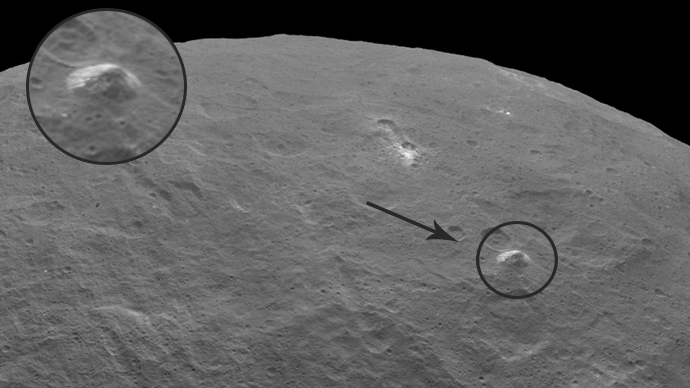
The mystery surrounding the dwarf planet Ceres continues to thicken: New images taken by the Dawn probe have revealed a three-mile high pyramid shaped peak, while also giving updated photographs of the planet’s puzzling bright spots.
The craft took the photographs on June 9 from a distance of 2,700 miles (4,300 kilometers). It revealed a number of new geographical characteristics, in particular, the high peak that juts out from the surrounding landscape.
“The surface of Ceres has revealed many interesting and unique features. For example, icy moons in the outer solar system have craters with central pits, but on Ceres central pits in large craters are much more common. These and other features will allow us to understand the inner structure of Ceres that we cannot sense directly,” said Carol Raymond, deputy principal investigator for the Dawn mission, based at NASA’s Jet Propulsion Laboratory in Pasadena, California.

The Dawn spacecraft has been orbiting around the Ceres dwarf planet since March 6, which is found in the asteroid belt between Mars and Jupiter. The new images also helped to shed some light on the planets bright spots, which are located in a crater, which is about 55 miles in length.
“The bright spots in this configuration make Ceres unique from anything we’ve seen before in the solar system. The science team is working to understand their source,” Dawn principal investigator Chris Russell of the University of California, Los Angeles said in a statement last week.
“Reflection from ice is the leading candidate in my mind, but the team continues to consider alternate possibilities, such as salt,” the Christian Science Monitor reported.
Dawn will continue at its current altitude until June 30 and will continue to take images of Ceres. However, it will then descend to an altitude of 900 miles (1.450 kilometers) in early August, which will bring it even closer to the dwarf planet.

On April 13, photographs were released from the NASA probe, which first showed two bright spots, which have been puzzling space experts.
On visible light images taken beforehand, the two anomalous spots appear bright white, leading to speculations about so-called cryovolcanoes. But the newly-released infrared photos show that the spots have completely differing thermal properties.
“This dwarf planet was not just an inert rock throughout its history. It was active, with processes that resulted in different materials in different regions. We are beginning to capture that diversity in our color images,” Chris Russell, principal investigator for the Dawn mission, said.
Scientists are still not sure if the spots are water, ice, or “hydrated minerals,” but they can say for sure that stable ice would be problematic so close to the sun.
Furthermore, the neighboring Vesta asteroid and Ceres shine differently from each other and, as well as possess different types of craters – both observations hinting at completely different histories.
RELATED ARTICLES
- Mark Zuckerberg is Stockpiling on Gold Reserves, Preparing to Move to Bunker
- Doctors Sue Governor Gavin Newsom of California Over COVID 'Misinformation' Law
- LA Health Officials Say Maskless Emmy's Did NOT Violate Rules Because 'Hollywood Elite Are Protected & Special'
- California BANS 'In-Home Bible Studies' after Banning Church Singing, are these the End Times?
- Stanford study: COVID-19 much more widespread than thought, and NO MORE DEADLY THAN FLU











